Our 5 data-backed tables reveal what works vs what “experts” say…
5 Thought-Provoking Perspectives for Life Coaches
1/ The Contrarian Coach: Conventional Wisdom vs. Reality
| Conventional Coaching Advice | Contrarian Approach | Real-World Impact |
|---|---|---|
| Get certified before starting | Start with existing skills, get certified only when ROI is clear | Save $5,100 – $10,500 upfront certification costs, launch 6-12 months faster (source) |
| Build presence on all major social platforms | Focus on 1 platform where your ideal clients actually engage | Content strategies focused on specific platforms result in higher engagement |
| Create elaborate packages with multiple options | Offer one perfect “signature program” | Simplified choices improve decision-making and reduce choice paralysis (source) |
| Network at industry events with other coaches | Connect directly with potential clients in their existing communities | Direct client networking yields higher conversion rates (source) |
| Invest in professional branding and website | Use minimal viable web presence to start | Launch with just a free social profile + a checkout page to take payments (free in 2025 with CartMango) |
2/ The Minimum Viable Coaching Business: What You Need vs. What You Don’t
| Business Element | Minimum Viable Version | Can Wait Until Later | Why This Works |
|---|---|---|---|
| Legal Structure | Sole proprietorship with separate business bank account | LLC/Corporation formation | Get you up to speed quickly so you can get clients fast |
| Website | Social profile + a checkout page; or one-page site with clear offer and contact form | Multi-page site with blog | Single-page sites focused on conversion perform better for service businesses (source) |
| Client Management | Shared Google Drive folder and calendar | Dedicated CRM system | You and clients don’t need to spend time + energy learning “another tool” |
| Payment Processing | PayPal or Stripe basic integration | Complex checkout system with upsells / downsells | Consumers prefer trusted and familiar payment processors (source) |
3/ The Anti-Hustle Approach: Sustainable vs. Burnout
| Hustle Culture Approach | Anti-Hustle Alternative | Sustainability Outcome |
|---|---|---|
| Work 60+ hours weekly to “prove dedication” | Structure a focused 20-25 hour coaching week | Productivity decreases significantly beyond 35-40 hours/week (source) |
| Always-on availability for clients | Clear boundaries with dedicated response times | Work-life boundaries reduce burnout in helping professions |
| Constantly create content across platforms | Strategic content calendar with built-in rest periods | Quality-focused content strategies outperform high-volume approaches (sources) |
| Take any client who will pay | Carefully select clients who energize you | Coach-client fit greatly impacts coaching outcomes |
| Measure success by income only | Balance financial goals with wellbeing metrics | Well-being are increasingly prioritized these days (source) |
4/ Ethical Client Acquisition: Integrity-Based vs. Traditional Approaches
| Traditional Marketing Tactic | Ethical Alternative | Client Trust Impact |
|---|---|---|
| Using scarcity tactics (“Only 2 spots left!”) | Honest capacity communication | Trust is the foundation of business relationships |
| Making hyperbolic outcome promises | Sharing realistic client case studies | Authentic, verifiable testimonials build more trust than claims |
| Lead magnets with minimal value | Creating genuinely helpful free resources | Value-driven content marketing generates more qualified leads |
| High-pressure sales calls | Exploratory conversations focused on fit | Low-pressure approaches improve closing rates (source) |
5/ The Coaching Business Model Canvas: Conventional Business vs. Coaching Business
| Business Model Element | Generic Approach | Coaching-Specific Approach | Key Difference |
|---|---|---|---|
| Value Proposition | Features and benefits focus | Transformation and outcome focus | Coaching clients prioritize transformation outcomes |
| Customer Segments | Demographic targeting | Psychographic and mindset targeting | Psychographic targeting gets more clients (source) |
| Revenue Streams | Product-oriented pricing | Value and transformation-based pricing | Value-based pricing improves revenue |
| Key Activities | Generic business operations | Deep work, relationship building, skill development | Higher client retention rates and satisfaction scores |
| Key Resources | Physical and financial assets | Coach’s presence, methodology, and energy management | Coach presence is a factor in client satisfaction (source) |
These data-backed insights form the foundation of our approach. Now let’s build your minimum viable coaching business step by step.
Thinking about starting a life coaching business but feel overwhelmed by all the advice out there? You’re not alone. Most coaching business guides push expensive certifications, fancy websites, and working around the clock to “build your empire.”
But what if there was a simpler way?
This guide shows you how to launch a successful coaching business without the usual overhead, complexity, and burnout. Based on current research and real-world success stories, we’ll walk you through a proven, minimalist approach to starting your coaching practice.
–
Part I: Building Your Coaching Foundation
Discovering Your Coaching Identity
The first step in building your coaching business is figuring out what sets you apart. Most new coaches try to help everyone with everything. This approach rarely works.
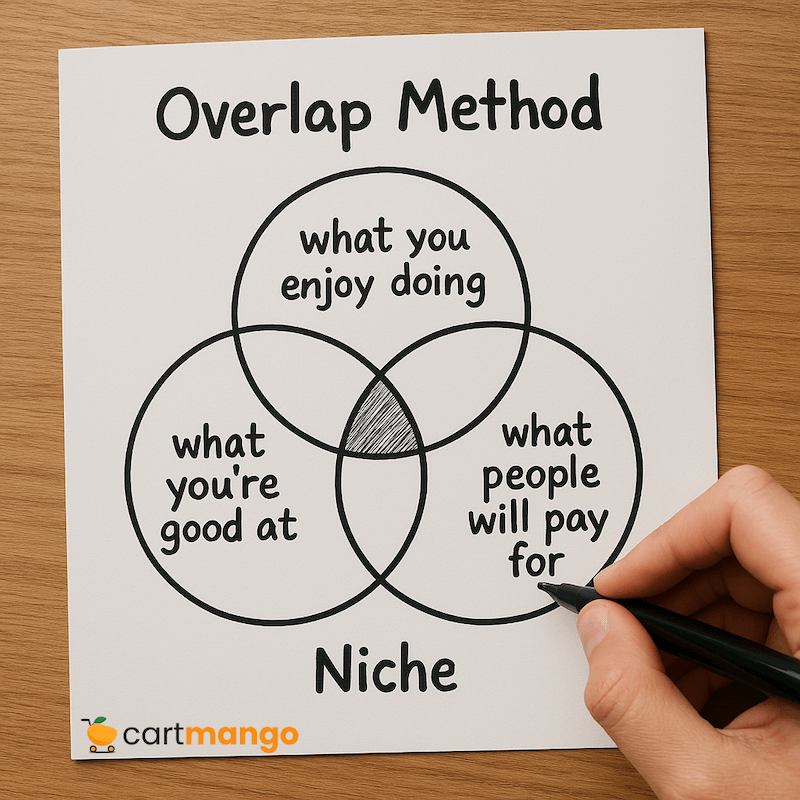
Start by using the “Overlap Method” to find your niche:
Draw three circles on a piece of paper.
In the first circle, write what you’re good at.
In the second, write what you enjoy doing.
In the third, write what people will pay for.
Where all three overlap is your perfect niche.
Next, create a coaching statement that clearly explains who you help and how.
Follow this simple formula:
“I help [specific type of person] achieve [specific outcome] through [your unique approach].”
Building credibility without expensive certifications is entirely possible. Coaching clients often value relevant experience and demonstrated results over formal certification. Start by documenting your own transformations and those you’ve helped informally.
Validate your niche by talking to 10 potential clients.
Don’t sell anything—just ask about their challenges and what solutions they’ve tried. These conversations cost nothing but provide valuable market research. If multiple people express genuine interest in solving the problem you address, you’re on the right track.
Creating Your Coaching Business Model Canvas
Every successful coach needs a roadmap. The Coaching Business Model Canvas helps you create one quickly.
Unlike generic business plans, this coaching-specific template focuses on transformation outcomes—which coaching clients prioritize.
Canvas Template
| Business Model Element | Description | Key Questions to Answer |
|---|---|---|
| Value Proposition | What transformation do you provide to clients? | What problem do you solve? What outcome do clients achieve? |
| Customer Segments | Who are your ideal clients? | What mindsets, challenges, and aspirations do they have? |
| Customer Relationships | How do you interact with clients? | What type of relationship do clients expect? How do you build trust? |
| Channels | How do you reach and deliver value to clients? | Where do clients find you? How do you deliver your coaching? |
| Revenue Streams | How do you generate income? | What pricing model will you use? What is your value-based pricing strategy? |
| Key Activities | What core activities drive your business? | What must you do consistently to deliver your transformation? |
| Key Resources | What assets are essential to your success? | What personal qualities, methodologies and tools do you need? |
| Key Partners | Who helps you deliver your coaching? | What relationships and partnerships amplify your impact? |
| Cost Structure | What are your main expenses? | What investments are necessary for your coaching business? |
Example: Career Transition Coach
| Business Model Element | Generic Approach | Coaching-Specific Approach | Key Difference |
|---|---|---|---|
| Value Proposition | Six 1-hour coaching sessions over 3 months | Transformation from career confusion to confident career change with proven 3-phase methodology | Focuses on the outcome (successful career transition) rather than features (number of sessions) |
| Customer Segments | Professionals aged 30-45 | Mid-career professionals feeling stuck and uncertain about next steps, seeking meaningful work aligned with their values | Targets based on mindset and readiness rather than demographics alone |
| Customer Relationships | Professional service provider | Trusted guide and accountability partner who balances challenge and support | Creates deeper connection focused on transformation |
| Channels | Website and social media | Client-centered content on LinkedIn, referrals from past clients, virtual delivery with occasional in-person intensive sessions | Focuses on platforms where career-minded professionals already gather |
| Revenue Streams | $200 per hour session | $3,000 for complete “Career Clarity & Transition” program (value-based pricing) | Prices based on the value of a successful career transition, not time spent |
| Key Activities | Marketing, scheduling, coaching, billing | Deep listening, powerful questioning, strengths assessment, industry research, network building | Coaches who focus on deep work and relationship building report higher client retention rates and satisfaction scores |
| Key Resources | Office space, computer, business account | Coach presence, career transition methodology, energy management, networking connections, assessment tools | Emphasizes intangible assets that create client transformation |
| Key Partners | Website developer, accountant | Resume writers, LinkedIn profile experts, industry insiders for informational interviews, alumni networks | Creates an ecosystem of support for client success |
| Cost Structure | Office rent, software, marketing expenses | Professional development, assessment tools, networking events, mastermind membership | Invests in resources that directly improve client outcomes |
Setting Essential Business Foundations
Start with the simplest legal structure that protects you.
For many new coaches, a sole proprietorship with a separate business bank account should be enough.
Create basic financial systems to stay organized.
You need:
A separate business bank account
A simple spreadsheet to track income and expenses
A folder (physical or digital) for receipts and tax documents. These three elements keep most coaches compliant with tax laws.
Establish clear boundaries between personal and business finances from day one. This simple step prevents tax headaches and helps you see if your business is truly profitable.
–
Part II: Designing Your Sustainable Coaching Practice
The Anti-Hustle Work Structure
The myth that you must work 60+ hours weekly to succeed is just that—a myth.
Structure a focused 20-25 hour coaching week instead.
Divide your time into 3 categories:
client sessions (10-12 hours)
business development (5-8 hours)
rest/reflection (5 hours)
This balance prevents burnout while maximizing effectiveness.
Implement strategic rest periods between clients and workdays. Work-life boundaries can greatly reduce burnout in helping professions like coaching.
Set clear boundaries with dedicated response times. Let clients know you respond to messages during specific hours (e.g., 10am-4pm weekdays) and require 24-hours notice for scheduling changes.
Creating Your Signature Coaching Offer
Instead of creating multiple offers that confuse potential clients, focus on one perfect program. The paradox of choice shows that simplified choices improve decision-making and conversion rates.
For your signature program, determine a clear length and structure. Most successful coaching programs run 8-12 weeks with sessions every 1-2 weeks. This timeframe is long enough to create transformation but short enough to maintain momentum.
Use value-based pricing rather than hourly rates. Price based on the value of the transformation you deliver, not the time spent.
Build your package with clarity and simplicity.
Include:
session frequency and duration
start and end dates
communication between sessions
any resources or tools provided
measurement of progress
This clear structure makes clients feel secure in their investment.
Establishing Your Online Presence
You don’t need an elaborate website to start. Just a one-page that includes the following will do:
your coaching statement
the problem you solve
your solution/approach
credentials and trust factors
a clear call to action
Choose one social platform where your ideal clients already gather. Create a sustainable content strategy with built-in rest periods. Plan one quality post weekly rather than daily mediocre content.
Find your authentic voice by speaking to one ideal client. Write as if you’re having coffee with them. Skip industry jargon and fancy language.
–
Essential Coaching Skills
Now that you’ve structured your sustainable practice, let’s focus on the coaching skills that will differentiate you in the coaching industry.
While your business framework matters, the coach client relationship is what transforms clients’ lives.
Unlike traditional businesses where operations can be separated from service delivery, your coaching process is your product. Strong active listening, powerful questioning, and goal-setting abilities form the foundation of effective personal development work. These core skills matter more than expensive coach training when starting out.
Your life coaching services will evolve naturally as you work with your first few clients. Each session builds your confidence and refines your approach to helping clients achieve their personal and professional goals. This hands-on experience often proves more valuable than theoretical training alone.
Different coaching niches require specialized approaches. Whether you’re drawn to money coaching, supporting small business owners, or joining other relationship coaches, your own coach identity emerges through client work. General life coach practitioners often discover their specialty after working with diverse clients, allowing their coaching practice to evolve organically.
–
Part III: Essential Tools
The 4 Essential Tools Every Coach Needs
When starting out, you need only five core tools, not dozens of complex systems. Keep it simple with these essentials:
1/ Cart/Order-Taking + Program Delivery
CartMango is specifically built for solo coaches and creators.
Unlike generic solutions, it lets you set up your coaching offer for sale in just 1 minute. The platform is completely free throughout 2025—you only pay the standard Stripe/PayPal processing fees that go directly to them.
Setting up a frictionless checkout process makes a huge difference in conversion rates. With CartMango, you can create a clean, simple checkout page in 1 minute. According to Baymard Institute research, simplified checkouts improve conversion rates.
Order bumps (additional offers shown during checkout) can increase your average sale value without being pushy. For example, offer a relevant workbook or additional session as an easy add-on. CartMango makes this setup straightforward.
CartMango’s post-purchase delivery system automatically sends clients their welcome materials, session links, and resources. This automation saves hours of manual work each week.
You can sign up for a CartMango account for free here (good through 2025).
Disclaimer: You’re on CartMango’s site, so we’re definitely biased 🙂
2/ Scheduling System
Use a simple scheduling tool like Calendly or YouCanBookMe to eliminate the back-and-forth emails when booking sessions. Both offer free plans adequate for new coaches.
3/ Video Conferencing Platform
Zoom’s free plan works perfectly for most coaches starting out. It provides 40-minute meetings (you can simply restart for longer sessions) and looks professional to clients.
4/ Client Resource Management
A simple Google Drive folder organized by client name provides sufficient document management at zero cost. Create a standard folder structure for each client to store session notes, worksheets, and resources.
–
Part IV: Ethical Client Acquisition
The Service-First Marketing Philosophy
Put service before sales in all your marketing efforts. This approach builds trust and credibility from the start.
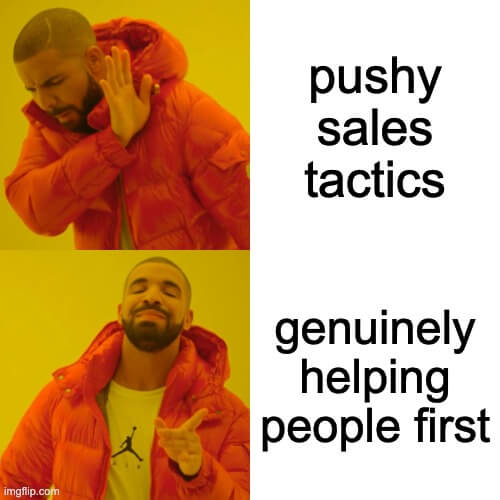
Create genuinely helpful free resources instead of thin lead magnets.
Build reputation through generosity and integrity.
Focus on aspiration and possibility in your messaging rather than triggering fear or insecurity.
The Conversation-Based Client Approach
Instead of complex marketing funnels, start with human connection.
Have genuine conversations with 30-50 potential clients or referral sources within 90 days.
Use natural, non-pushy outreach scripts.
For example:
“I’m focusing my coaching practice on helping [ideal client type] with [specific challenge]. Based on your experience, I’d love to get your thoughts on this for 15 minutes. No pitch, just gathering insights.”
This transparent approach respects boundaries while opening doors.
Convert conversations to consultations without awkwardness by asking permission:
“Based on what you’ve shared, I think I might be able to help. Would you be open to a more focused conversation about how we might work together?”
Track your conversation results in a simple spreadsheet.
Note who you spoke with, key points discussed, follow-up items, and outcomes.
Review this data monthly to refine your approach.
Client Experience Systems
Create a simplified onboarding process that makes clients feel valued and prepared.
Include:
a welcome email
intake questionnaire
first session preparation guide
Develop an essential session structure to deliver consistent results.
A proven format includes:
check-in (5 min)
progress review (10 min)
deep exploration (30 min)
action planning (10 min)
wrap-up (5 min).
Following a consistent structure helps clients feel secure while allowing flexibility in content.
Implement simple progress tracking to demonstrate value. Create a 1-10 scale assessment for key areas clients want to improve and review regularly.
Design offboarding that generates referrals.
In the final session, include a structured review of progress, celebration of wins, sustainability planning, and a clear path for future connection.
End with a simple but powerful question:
“Who do you know who might benefit from a similar transformation?” This question can effectively generate referrals.
Digital Strategy Tips For Your Online Coaching Business
With your client acquisition approach in place, it’s time to optimize your life coaching business online. The digital landscape offers unique advantages for coaches seeking a profitable business with minimal overhead.
While traditional businesses require physical locations, your online coaching business can reach clients globally. This approach not only reduces costs but also expands your target audience beyond geographical limitations.
A focused coaching website and strategic use of social media accounts create touchpoints where potential life coaching clients can discover your unique approach.
When selecting a coaching platform, prioritize simplicity and client experience over complex features. Many successful coaches use straightforward tools that support video calls, payment processing, and resource sharing without unnecessary complications.
This streamlined approach keeps your online business manageable while you focus on serving clients.
Business owners in the coaching space often wonder about the average life coach salary. While ranges vary from $30,000 to over $100,000 annually, your income depends more on your business structure, marketing strategy, and coaching package design than industry averages.
Executive coaches typically command higher rates, but even a general practice can become a thriving business when you consistently attract clients who value your specific expertise.
–
Part V: Streamlined Business Operations
Financial Management Simplified
Track only essential metrics at the start.
Focus on:
monthly revenue
number of active clients
conversion rate from consultations
average client value.
These four metrics tell you most of what you need to know about business health.
Balance financial goals with wellbeing indicators. Monitor your energy levels, satisfaction with client work, and work-life balance weekly on a 1-10 scale.
Use a simple tracking system like a Google Sheet or free version of Wave Accounting. Avoid complex software until your business grows.
Review your financial data monthly to spot trends and make adjustments. Set a recurring calendar appointment for this review.
Client Selection and Boundaries
Carefully select clients who energize you rather than drain you.
Coach-client fit greatly impacts coaching outcomes. Create a simple “ideal client checklist” and review it before accepting new clients.
Establish communication protocols that prevent 24/7 availability. Clearly state your response times in your welcome materials.
For example: “I respond to messages within 24 hours during business hours (Monday-Thursday, 9am-5pm).”
Learn to say no to opportunities that don’t align with your goals or energy.
Create a decision framework with three questions:
Does this align with my business goals?
Do I have the time and energy?
Is the compensation fair?
If any answer is no, decline politely.
Explain your availability to clients confidently, framing boundaries as beneficial to their coaching experience.
Example: “To ensure you receive my best energy and focus during our sessions, I limit my coaching hours to 15 per week.”
This shows you have clear boundaries, showing you as more professional.
Optimizing Your Sales Funnel
Create a frictionless purchasing experience with CartMango. Set up a simple checkout page that includes: program description, price, what’s included, and testimonials (when you have them). The platform’s clean interface removes distractions that might prevent clients from completing their purchase.
Leverage automatic fulfillment to save time and delight clients. Use CartMango to instantly deliver welcome materials and next steps after purchase. This automation ensures clients receive immediate value and clear direction while saving you hours of manual work.
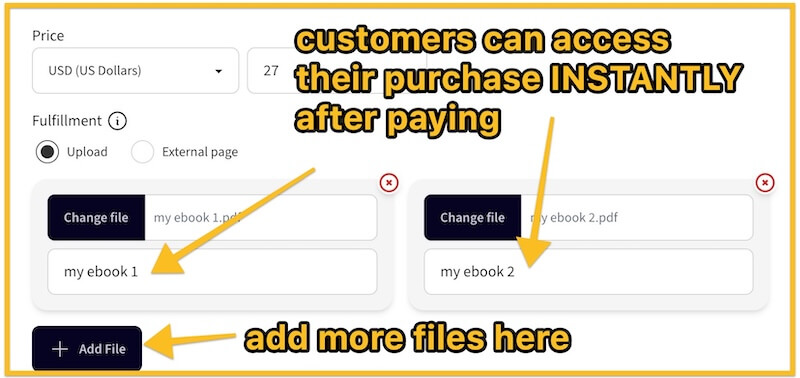
Implement security mechanisms to protect your digital offers. CartMango provides secure delivery of your coaching materials and resources, preventing unauthorized sharing. This protection maintains the value of your intellectual property as your business grows.
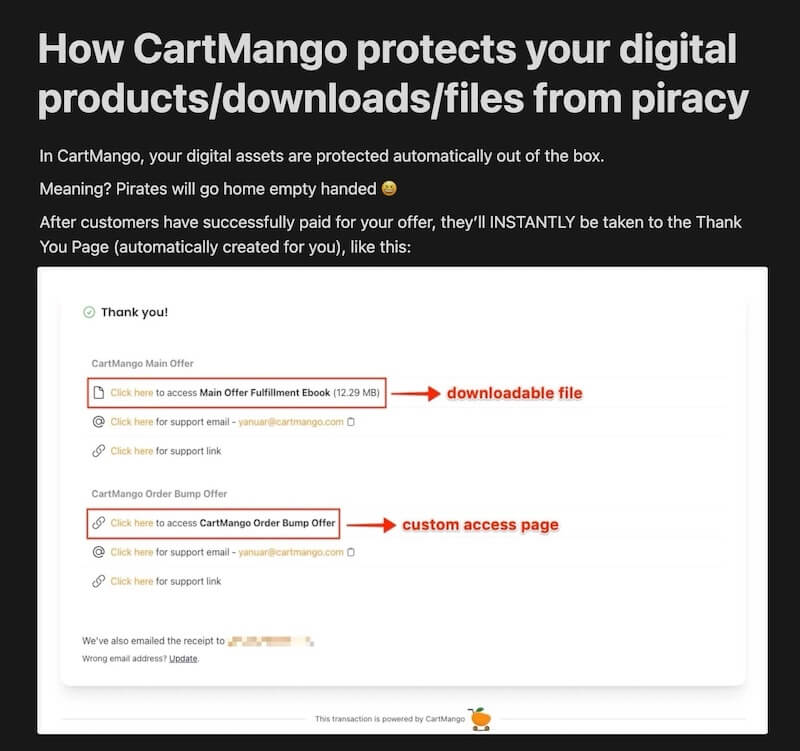
Click here if you want more details on how the protection mechanism works.
Get paid instantly with direct-to-account payments.
Unlike some platforms that hold funds for days, CartMango works with Stripe and PayPal to deposit payments directly into your account.
–
Part VI: Growth and Evolution
Knowing When to Scale Beyond Minimum Viable
Watch for key indicators that signal readiness for growth.
These include:
Consistent client roster (80%+ capacity for 3+ months)
Strong repeat business or referrals (50%+ of new clients)
Positive cash flow with 3+ months of expenses saved
Pay attention to client feedback patterns. When multiple clients request additional services or longer-term support, it’s a strong signal to consider expansion.
Monitor financial benchmarks that indicate growth potential. Look for profit margins above 30%, consistent monthly revenue for 6+ months, and client acquisition costs below 25% of client lifetime value. These metrics suggest your business model is ready for scaling.
Assess your personal readiness using a simple energy audit. Rate your energy and enthusiasm at the end of each workday for two weeks. If you consistently score high, you likely have the capacity to grow.
Ethical Scaling Strategies
Add complementary offers that maintain your values and quality standards.
Common options include:
Group coaching programs
Self-paced courses
Short intensive workshops
Leverage technology to serve more clients without more time.
Consider tools that automate repetitive tasks while maintaining personal connection. E.g. You could implement automated check-ins between sessions using an email tool like BirdSend.
Create systems that preserve quality as you grow. Document your coaching methodology, client journey, and standard operating procedures. This documentation ensures consistent quality even as you expand.
Maintain work-life balance while growing by setting growth ceilings. Decide in advance the maximum clients, hours, or revenue you’ll accept before making structural changes. This is called “purposeful growth” and it’ll prevent burnout.
Future-Proofing Your Coaching Business
Stay ahead of industry trends by allocating 2-3 hours monthly for research and continuing education.
Follow key organizations like the ICF, read industry reports, and participate in professional communities. This small time investment helps you adapt before changes disrupt your business.
Implement diversification strategies for sustainability.
Consider creating multiple income streams such as:
affiliate partnerships
complementary services
Build resilience by maintaining low overhead and 3-6 months of operating expenses in reserve. This buffer allows you to innovate and adapt without financial pressure.
Create a flexible 3-year vision that focuses on direction rather than rigid goals. Review and adjust quarterly based on market changes and personal insights.
–
Part VII: The 60-Day Minimum Viable Launch Plan
Phase 1: Foundation (Days 1-15)
Start with daily action steps for business setup. Spend 1-2 hours each day on foundational elements.
Begin with your Coaching Business Model Canvas, then register your business name, set up a business bank account, and create your coaching agreement.
Complete your Coaching Business Model Canvas by the end of week one. Use the template mentioned earlier and spend 60-90 minutes filling it out completely. Review and refine it with a trusted colleague if possible.
Set up your minimum viable systems next.
These include: Google Drive for document storage, a simple bookkeeping spreadsheet, and a calendar system for appointments.
Create your core coaching offer by the end of day 15. Define your signature program with clear parameters: duration, frequency, deliverables, and price. Keep it simple and focused on one clear transformation.
Phase 2: Implementation (Days 16-30)
Set up your CartMango checkout page for your coaching offer.
Include a compelling description, clear pricing, and the specific benefits clients receive. Connect it to your payment processor (Stripe or PayPal) following CartMango’s simple setup instructions.
Create your one-page website during this phase. Use a simple platform like Carrd or a free WordPress template.
Include: your coaching statement, the problem you solve, your solution, and a link to your CartMango checkout page.
Prepare for client acquisition conversations by creating your outreach script, ideal client profile, and discovery session structure. Practice with friends or peers to refine your approach.
Establish your anti-hustle schedule before you start client work. Block specific hours for coaching, marketing, and rest. Protect these boundaries from day one to prevent burnout patterns from forming.
Phase 3: Acquisition (Days 31-60)
Reach out to 5-7 potential clients or referral sources each week.
Focus on being helpful rather than selling.
Conduct discovery sessions with interested prospects. Use a consistent format: establish rapport (5 min), understand their situation (15 min), explain how you can help (10 min), discuss working together (10 min), and outline next steps (5 min).
Enroll your first paying clients through your CartMango checkout. Send them a direct link after a successful discovery call. Include a personal note reiterating the value they’ll receive. This personal touch can increase conversion compared to generic follow-ups.
Track your results daily during this phase. Note the number of conversations, discovery sessions scheduled, and clients enrolled.
Use this data to refine your approach weekly. Look for patterns in what’s working and adjust accordingly.
Next Step
The single most important action to take today is completing your Coaching Business Model Canvas.
This foundation guides everything else. Download the template and spend 60-90 minutes filling it out completely. This clarity alone puts you ahead of most aspiring coaches.
Common obstacles you’ll face include:
perfectionism
imposter syndrome
overcomplication.
Combat these by setting clear deadlines, focusing on helping rather than being perfect, and constantly asking:
“What’s the simplest way to achieve this?”
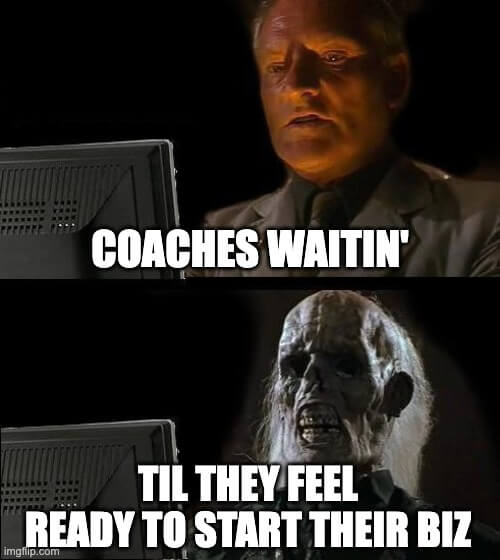
Build supportive connections early in your journey. Join one coaching community or mastermind where you can share challenges and wins. Coaches with professional support networks are more likely to sustain their practices long-term.
Building a coaching business is about helping others transform while creating a sustainable practice for yourself.
Start small, focus on quality over quantity, and grow intentionally. Your minimum viable coaching business can create maximum impact without maximum stress.
–
Life Coaching Business FAQs
As you prepare to launch your own coaching business, you likely have questions about applying our contrarian approach. Here are straightforward answers to common concerns:
How can I find my first few clients without an established reputation?
Direct outreach to your network with a service-first mindset generates clients more effectively than passive marketing or social media for new coaches.
Do I need to form a limited liability company immediately?
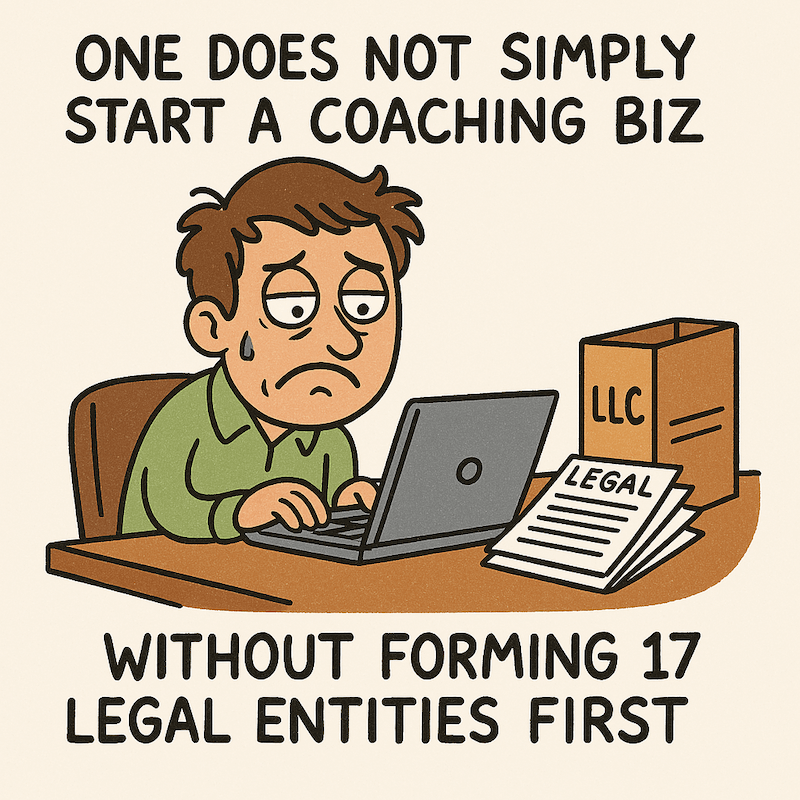
No. Most coaches begin as sole proprietors and transition to formal business structures only after consistent income. This contrarian approach saves hundreds in formation costs and unnecessary paperwork.
How can I stand out in a crowded coaching industry?
Rather than trying to appeal to everyone, define a specific target audience with shared challenges and aspirations. Your personal development background combined with specialized focus creates a unique position that larger, generic coaching services cannot match.
What’s the minimum viable coaching package I should offer?
Create a single signature offering rather than multiple options. Simpler offerings convert better. Focus on solving one specific problem for dream clients rather than creating comprehensive programs that overwhelm both you and clients.
How do I balance coaching with running my own business?
Use the anti-hustle framework we outlined. Allocate specific days for client work and separate time for business development. This boundary-focused approach prevents the common trap of working constantly but accomplishing less.
Should I invest in online courses to improve my skills before launching?
Contrary to popular advice, start with what you know and improve through real client work. The successful business coach prioritizes practice over endless preparation. Your unique perspective is already valuable to the right clients—don’t delay sharing it.
How important is a professional coaching website when starting out?
While many experts insist on a polished coaching website from day one, a simple one-page site converts better than complex multi-page designs.
Focus on clearly communicating your transformation promise and how to book a call. You can create an effective site in a single day using platforms like Carrd or Google Sites, then upgrade only when client volume justifies the expense.
Should I create online courses right away to diversify my coaching business?
Contrary to popular advice, focus on mastering your one-to-one coaching service before developing online courses.
Many coaches dilute their impact by launching courses too early.
The thriving business approach is sequential: perfect your coaching methodology with individual clients first, document your process, then consider scaling through courses once you have proven results and testimonials. This approach leads to higher-quality offerings and better conversion rates.
Related
- SendOwl vs Gumroad: The Recurring Revenue Black Hole (2026)
- Gumroad vs Sellfy: The Vendor Lock-in Cage (2025)
- Gumroad vs Payhip: The Hidden Trap for Creators (2025)
- ThriveCart vs SamCart – The Subscription Hostage Trap (2025)
- 8 ThriveCart Alternatives & The Lifetime Pricing Paradox (2025)
- 8 SamCart alternatives + Subscription hostage (2025)
- The GENTLE Method: Soft marketing for creators
- How Far in Advance Should You Promote a Webinar?
- The SAVINGS Method: The Productivity Improvement Plan for Creators
- 9 Questions to Ask: How to Hire a Digital Marketing Agency
